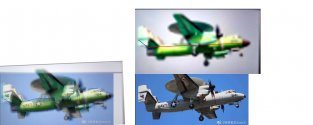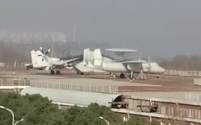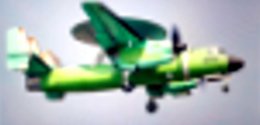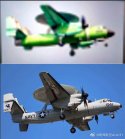You are using an out of date browser. It may not display this or other websites correctly.
You should upgrade or use an alternative browser.
You should upgrade or use an alternative browser.
KJ-600 carrierborne AEWC thread
- Thread starter Blitzo
- Start date
That airframe is such a close copy of the American one I can actually believe the design was lifted from industrial espionage. Sure it saves time and money to not reinvent the wheel and that design clearly works for carriers with the general layout basically confirmed by the Soviets/Russians. But I think the almost 1:1 airframe (internals and equipment obviously different) does indicate that the US industry/military surely has some leaks.
The outline specs could be easily obtained by buying scale model from the market, the real important differences lies inside, and that could not be judged by eyeballing.That airframe is such a close copy of the American one I can actually believe the design was lifted from industrial espionage. Sure it saves time and money to not reinvent the wheel and that design clearly works for carriers with the general layout basically confirmed by the Soviets/Russians. But I think the almost 1:1 airframe (internals and equipment obviously different) does indicate that the US industry/military surely has some leaks.
We had that satellite image at the factory some months back. There, with the help of GE measurement i concluded KJ600 was likely at least half a meter longer than E2C.
So, using 18 meters length for KJ200, i produced the comparisons below, which i feel are pretty good actual relative size comparisons.
The image on the left has those blue lines, those are the outlines of the fuselage. So it'd appear that not only is KJ600 longer but its fuselage is also at least higher (if not also wider, which is likely too) than E2's. Image on the left shows how much longer KJ600 is. Though keep in mind the angle of the plane is not identical, so KJ200 is slightly shorter than it first appears. (still longer than E2)
Other apparent differences, besides the obvious tail section, is the much bigger nose radome. Suggesting KJ200 might have a proper radar up there, and not just a weather radar like commercial airliners or E2 has. Different color at the tail might also suggest some kind of radome, but that's way too hard to be sure of. Certainly, there would be some benefits to having nose and tail radars. The main radar dish is fairly small and pretty flat. Assuming KJ600 radar also operates in UHF band, as does E2, then all those facts combined mean the vertical resolution of that main radar dish is abysmal, for modern standards. Which in turn may make it worthwhile to have some added radars with half decent vertical resolution. So once a contact is detected, the plane can briefly take a look at it with its other radars to get some further contact/tracking details.
Another difference is slightly longer engine. Whether that means a more powerful engine is impossible to say. But given that KJ600 does seem to be slightly bigger than E2D, one shouldn't be surprised if it's also heavier. (Don't know if E2D reused same fuselage materials/construction as E2C. Even if it did not, larger planes packed with new electrpnics still tend to be heavier, even if featuring more composites, than older, smaller planes)
The dish itself seems of generally the same diameter and position, relative to the plane.

Of course, all this is based on that image, not the the real plane. So if it's a CG or otherwise doctored photo, then we still don't know anything.
So, using 18 meters length for KJ200, i produced the comparisons below, which i feel are pretty good actual relative size comparisons.
The image on the left has those blue lines, those are the outlines of the fuselage. So it'd appear that not only is KJ600 longer but its fuselage is also at least higher (if not also wider, which is likely too) than E2's. Image on the left shows how much longer KJ600 is. Though keep in mind the angle of the plane is not identical, so KJ200 is slightly shorter than it first appears. (still longer than E2)
Other apparent differences, besides the obvious tail section, is the much bigger nose radome. Suggesting KJ200 might have a proper radar up there, and not just a weather radar like commercial airliners or E2 has. Different color at the tail might also suggest some kind of radome, but that's way too hard to be sure of. Certainly, there would be some benefits to having nose and tail radars. The main radar dish is fairly small and pretty flat. Assuming KJ600 radar also operates in UHF band, as does E2, then all those facts combined mean the vertical resolution of that main radar dish is abysmal, for modern standards. Which in turn may make it worthwhile to have some added radars with half decent vertical resolution. So once a contact is detected, the plane can briefly take a look at it with its other radars to get some further contact/tracking details.
Another difference is slightly longer engine. Whether that means a more powerful engine is impossible to say. But given that KJ600 does seem to be slightly bigger than E2D, one shouldn't be surprised if it's also heavier. (Don't know if E2D reused same fuselage materials/construction as E2C. Even if it did not, larger planes packed with new electrpnics still tend to be heavier, even if featuring more composites, than older, smaller planes)
The dish itself seems of generally the same diameter and position, relative to the plane.

Of course, all this is based on that image, not the the real plane. So if it's a CG or otherwise doctored photo, then we still don't know anything.
That airframe is such a close copy of the American one I can actually believe the design was lifted from industrial espionage. Sure it saves time and money to not reinvent the wheel and that design clearly works for carriers with the general layout basically confirmed by the Soviets/Russians. But I think the almost 1:1 airframe (internals and equipment obviously different) does indicate that the US industry/military surely has some leaks.
The structural configuration and planform of the E-2 family have been out in the open for years now, it's not exactly something which requires espionage to attain.
There are certain characteristics for an aircraft to be a reverse engineered product, in particular having identical key dimensions. I'd be interested to see if H-600 has a similar or different fuselage geometry (length, diameter etc), not to mention control surfaces, and landing gear. If those are different, coupled with the obviously different engines, then what you have is basically an entirely different aircraft despite what seems like some barn door "similarities" like 737 and A320.
I wouldn't be surprised if the Chinese had highly detailed information on the E2C. It was exported to several countries including Egypt, Taiwan, Israel, and Singapore. It isn't a particularly new aircraft either. Heck, one of them is in a museum.
Last edited:
But the KJ600 ought to, hopefully, show the Chinese proficiency with electronic systems. Just like the Z-20 vs Blackhawk, I expect KJ-600 to be quite capable with the innards.I wouldn't be surprised if the Chinese had highly detailed information on the E2C. It was exported to several countries including Egypt, Taiwan, Israel, and Singapore. It isn't a particularly new aircraft either. Heck, one of them is in a museum.
But what radar is KJ-600 using? What's the specs?
But the KJ600 ought to, hopefully, show the Chinese proficiency with electronic systems. Just like the Z-20 vs Blackhawk, I expect KJ-600 to be quite capable with the innards.
But what radar is KJ-600 using? What's the specs?
Of course. It should be a lot more advanced electronically. If the KJ-500 specs are any indication it should have AESA radar.



